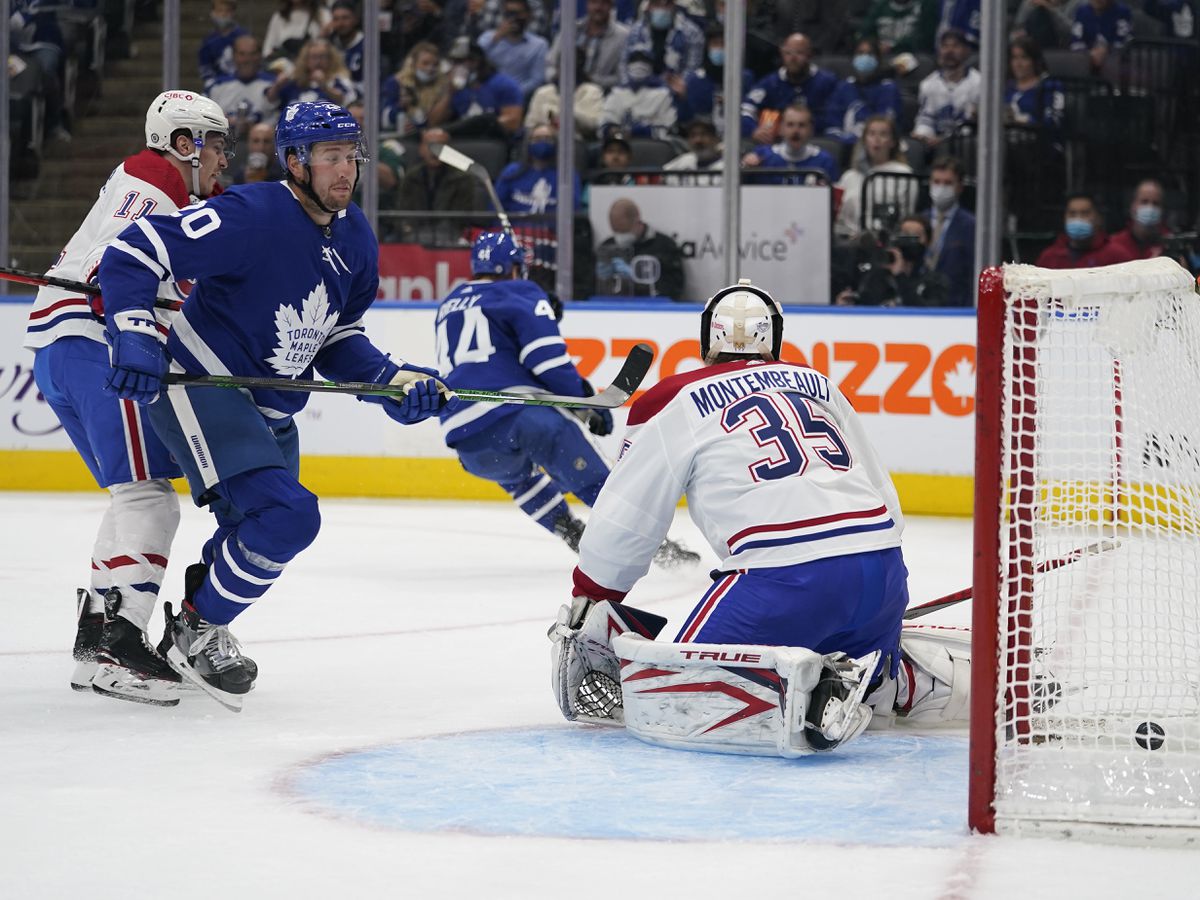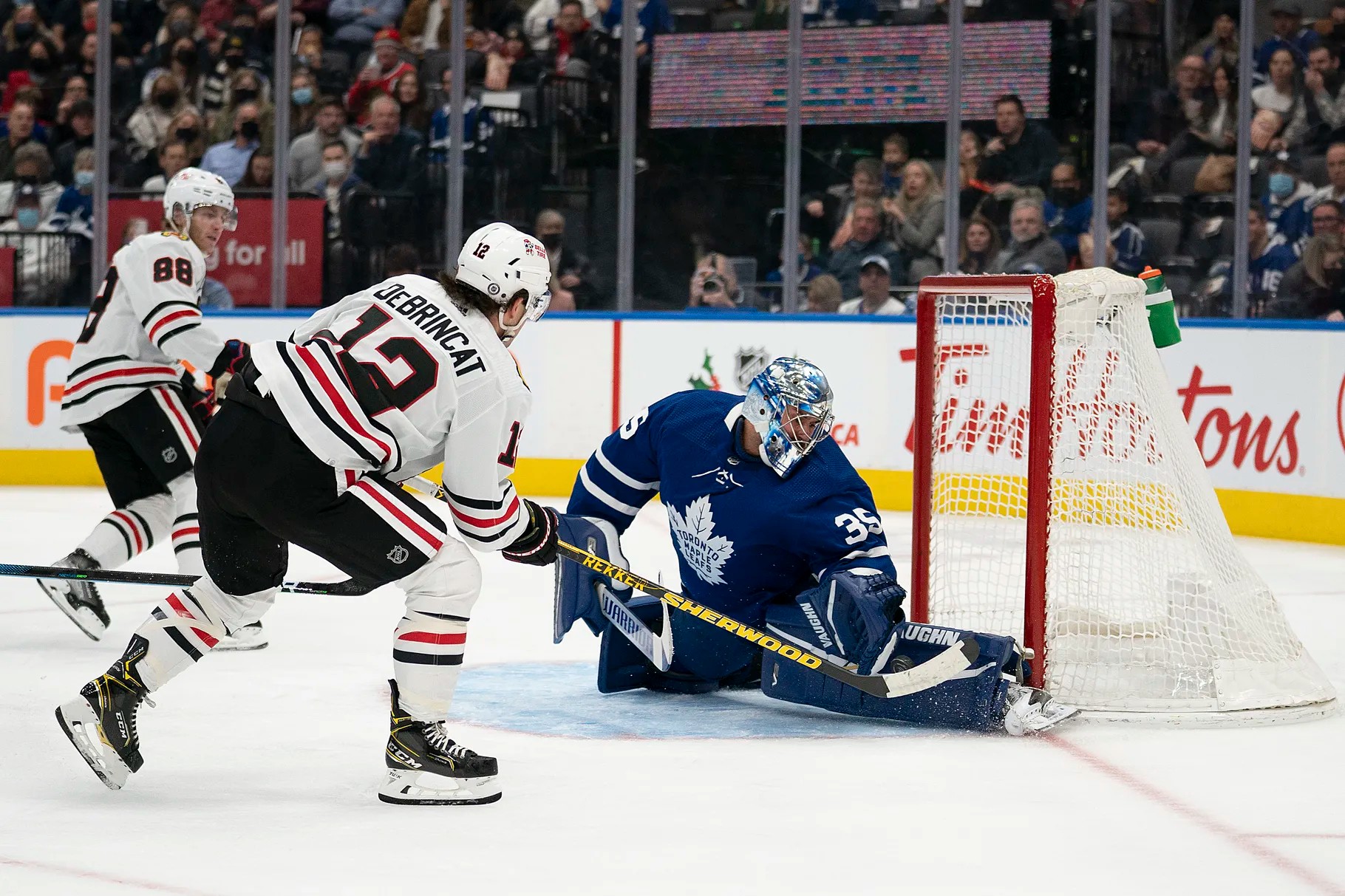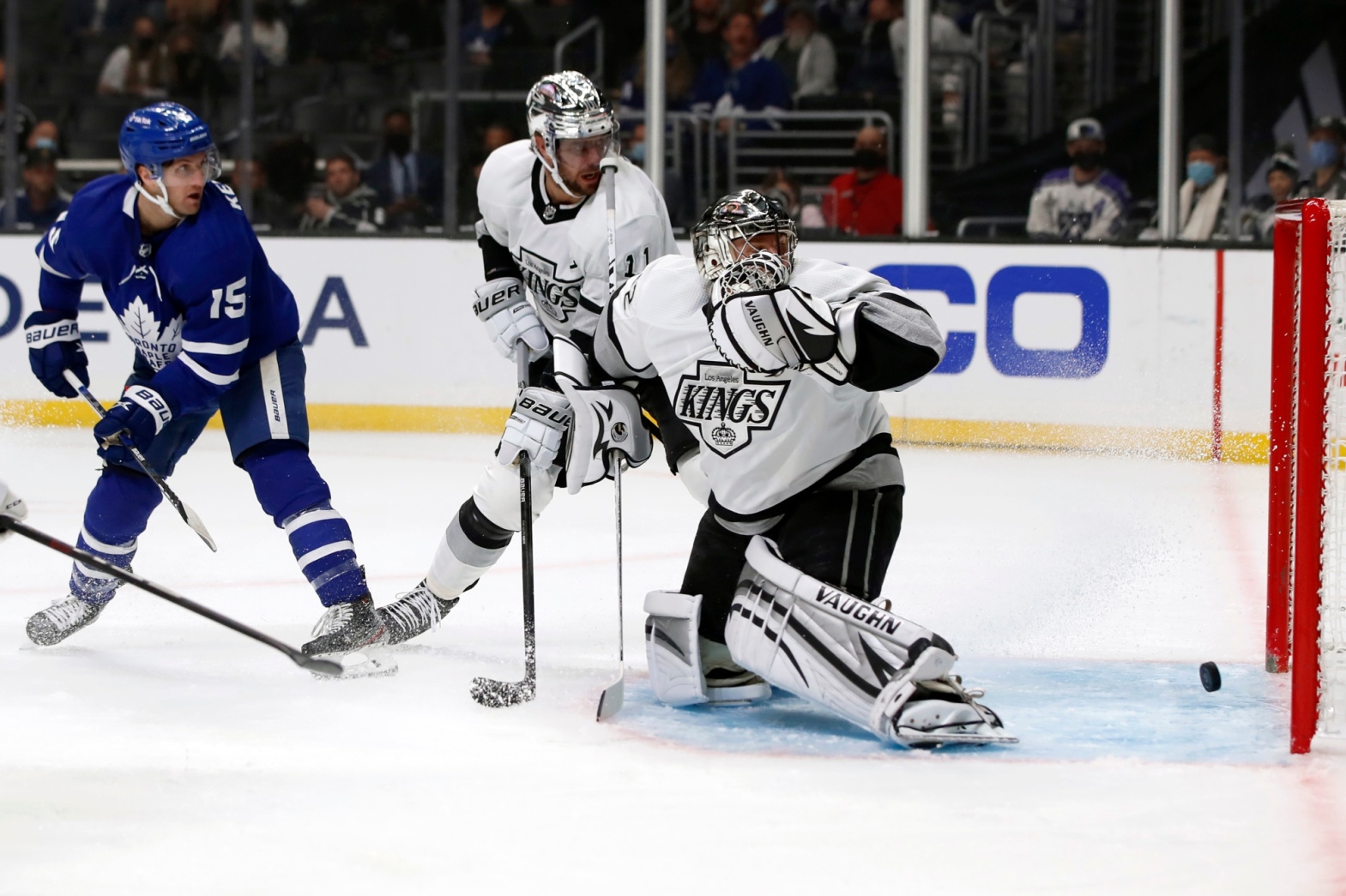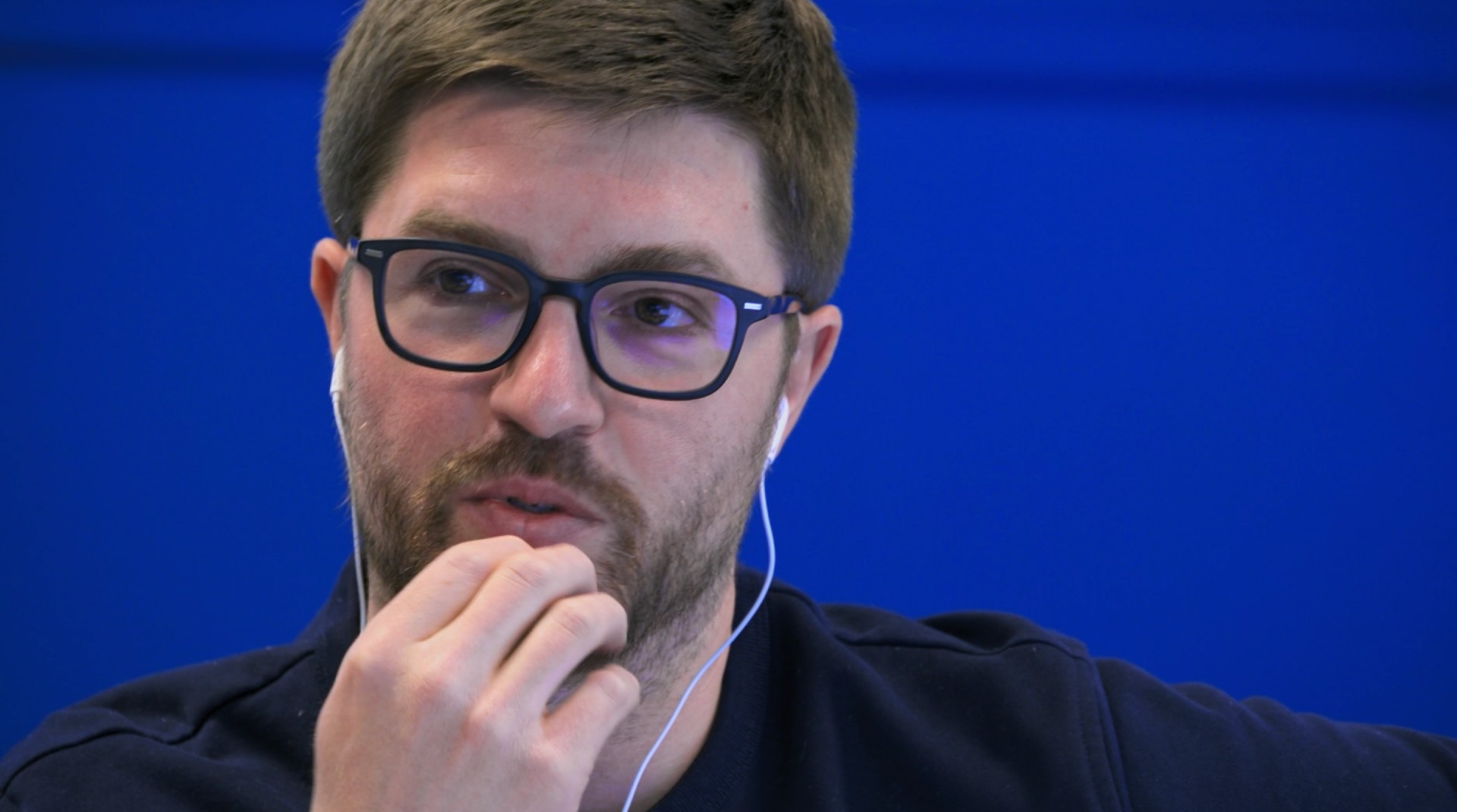There’s not exactly a clear path for the Maple Leafs at this year’s trade deadline.
The team has two legitimate NHL goalies, seven legitimate NHL defensemen, and at least 12 legitimate NHL forwards. While there is certainly room for improvement, there are no major holes on this Leafs roster right now. Adding a league-average player won’t move the dial much at all.
On defense, the Leafs don’t need another third-pairing option. Perhaps they can find an upgrade over Justin Holl in the top four, but if you’re giving up a first-round pick, you better be sure that you’re acquiring a significant upgrade.
At forward, Pierre Engvall would likely be the one who comes out of the lineup if an addition was made, but he’s grading out extremely well by Evolving Hockey’s RAPM at the moment:
Giving up future assets only makes sense if the team is acquiring a difference maker. While some fans don’t like Engvall due to his lack of physicality for a big man, I see a good two-way player who can help his team in transition. Players such as Spezza and Simmonds benefit from that type of skill set; the fourth line looks lost without Engvall.
While Holl hasn’t had his best season, he did post strong results with Muzzin in the past, and there is a chance that they get back to that form again. The last thing the Leafs want to do is move assets for a downgrade.
Any move must focus on quality over quantity. While the rental market could have some interesting names such as Tomas Hertl, Joe Pavelski, John Klingberg, or Claude Giroux, it’s possible that only one or two of those players is moved. In an ideal world, you pay a little bit extra for a player with another year or two of control, but the Leafs‘ cap situation makes it tricky to acquire anyone with a big contract.
Given Toronto’s depth, they should put NHL roster players on the table. Alex Kerfoot is having a good season, but I certainly wouldn’t rule out including him as part of a deal for a legitimate difference maker. Justin Holl, Travis Dermott, and even Timothy Liljegren look like NHL contributors, but I’d include any of them in a deal for a major upgrade with term.
If the Leafs want to take a big step forward over the next two or three seasons, they’re going to have to make some tough decisions.
Damon Severson as a trade target
My #1 target for the trade deadline? Damon Severson of the New Jersey Devils.
The 6’2″ right-shooting defenseman would come with 1.5 seasons of term and a $4.17 million cap hit that is a veritable bargain. I see him as a legitimate difference maker who I’d be interested in signing to an extension if the price is reasonable. A top four of Rielly, Brodie, Muzzin, and Severson would be outstanding.
Here is the problem: New Jersey is under no pressure to move him. With a good young core of Jack Hughes, Nico Hischier, Jesper Bratt, Dawson Mercer, Alexander Holtz, Ty Smith, and Luke Hughes, the Devils will be trying to make the playoffs next season. Severson gives them a good 1-2 punch with Dougie Hamilton on the right side, where he can certainly help them become a playoff contender next season. He’s not going to come cheap.
Could a trade involving Severson for Liljegren make sense? The Leafs would receive a legitimate top-four defenseman on a bargain contract rather than someone with the potential to grow into one. The Devils would acquire a player who can step into an NHL role immediately, who fits their contention timeline, and who carries significantly more term. I think this type of trade could appeal to both teams, particularly if the Leafs would be interested in extending Severson.
The price for 1.5 seasons of Jake Muzzin was Sean Durzi, Carl Grundstrom, and a first-round pick. The fact that Liljegren is NHL ready increases his value, but I still think the Leafs would likely have to add more to get this done.
Obviously, how both teams evaluate Liljegren is a major question mark here. If the Leafs think he’s a sure-fire top-four defenseman — or if the Devils think he’ll be a fringe NHL player — this deal is probably off the table. If the two teams don’t align on Liljegren, the next question becomes: What about Topi Niemela?
The idea of moving Alex Kerfoot
At forward, Alex Kerfoot’s $3.5 million cap hit has made him a trade candidate for years. While he’s racked up points alongside Tavares and Nylander this season, his play-driving numbers such as RAPM are rather mediocre. The Leafs can probably find someone else to fill that role (Alex Galchenyuk also racked up his fair share of points there last season).
Kerfoot’s point production (27 points in 38 games), ability to play center or wing, and actual salary makes him an attractive trade piece. He could be traded as part of a package for a better player or flipped to a third team in exchange for an asset. In fact, Kerfoot was already involved in a similar deal earlier in his career for Nazem Kadri.
In a perfect world, I’d like to see the Leafs upgrade at center. Adding a high-end player to Matthews, Tavares, and Kampf would give you the framework to have four good forward lines. Kerfoot is the backup option at center at the moment, so if you trade him, you probably want someone back who can also play up the middle in the top-six if an injury occurs. The Leafs also have prospects on the way in Matthew Knies, Nick Robertson, Rodion Amirov, and Alex Steeves, who all play on the wing.
Hertl and Giroux are terrific players, but they might not end up getting traded and they would carry a hefty price for a rental. If the Habs commit to a rebuild, it could potentially make sense to inquire about Christian Dvorak, who carries a $4.45 million cap hit for the next 3.5 seasons. Montreal, after giving up a first and a second for him just this offseason, could look for a similar return rather than wasting those years of control on a rebuilding team.
Unfortunately, Dvorak grades out poorly by RAPM this season, and his five-on-five scoring production has been mediocre at best over the years. I’ll have to watch more of him, but at this point, I’m not sure if he’d be a significant upgrade.
Bo Horvat and J.T. Miller would fit the bill, but they both carry a cap hit over $5 million and neither player will come cheaply (especially if the Leafs pay extra for salary retention). However, can you imagine having one of them paired with Ondrej Kase on the third line? The Leafs would have themselves a three-line attack similar to Tampa Bay last year — that’d be worth paying a hefty price for.
I’d rather pay a little bit more for a legitimate difference maker than a marginal upgrade, so I think that both players are valid trade targets. However, you better have other options knowing the price could be astronomical.
The other team that could possibly end up moving a good center is the Seattle Kraken. Matthew Beniers, the second overall pick of the 2021 NHL Draft, is going to play center for the Kraken next season. Since the team already has a 1-2-3 of Jared McCann, Yanni Gourde, and Alex Wennberg up the middle, someone could potentially be expendable. Of course, they could always just move someone over to the wing, but if they want to stockpile picks and prospects, moving a center would accomplish that.
I like all three of Seattle’s centers. However, given that Wennberg carries a $4.5 million cap hit for the next 2.5 seasons, it’s tough to see the fit. There might be a match if the Kraken were willing to take back Nick Ritchie, but I’m not sure if Wennberg is a major upgrade over Kerfoot.
Yanni Gourde would obviously be an ideal third-line center (as his Stanley Cup rings would tell you), but his $5.17 million cap hit would be difficult to fit in. I won’t rule him out completely, but some serious creativity would be required there.
Could they acquire Leafs legend Jared McCann for the second time in a calendar year? Sure, they probably should have just kept him the first time, but that doesn’t mean they can’t trade for him now.
After spending plenty of time on the wing with the Penguins, McCann has been playing in between Jaden Schwartz and Jordan Eberle for most of the season, posting an impressive 24 points in 36 games. He is in line for a raise this offseason, but at his current $2.94 million cap hit, the Leafs wouldn’t necessarily have to move Kerfoot to fit him in this season. Toronto could opt to re-sign him, or simply use him as a rental and flip him in the offseason.
Of course, Seattle doesn’t have to move any of their centers, so it will take a half-decent offer to get him. However, even a good offer for McCann will surely cost less than Horvat or Miller. He’s worth calling about.
What To Do With Nick Ritchie?

After placing Nick Ritchie on waivers earlier this month, it’s clear that the Leafs would like to get out of this contract. Given that he was not claimed, Toronto will either need to give up an asset or take on another bad contract to move him. Knowing the Leafs will need every dollar of cap space they can scrounge up for next season, we can expect to see a trade sometime before the start of next season.
Ritchie carries a $2.5 million cap hit through next season, when his actual salary increases from $1.7 million to $3.3 million in 2022-23. It will be difficult to find a good suitor as a result. Cap teams won’t like the $2.5 million cap hit, while non-cap teams won’t like the $3.3 million salary.
Given that the Tampa Bay Lightning gave up Vladislav Kolyachnok and a second-round pick to get out of the last season of Anton Stralman’s deal, I expect that it will cost slightly less to move Ritchie.
One creative trade idea is to trade Ritchie to Ottawa for Michael Del Zotto. Like Ritchie, the 31-year old defenseman cleared waivers earlier this season and does not appear to be in his team’s future plans. There were eight defensemen on Ottawa’s NHL roster last week, but Del Zotto wasn’t one of them (and that’s with Nikita Zaitsev on the injured reserve). Del Zotto is ninth on their depth chart at best, with both Jake Sanderson and Lassi Thompson projecting to jump ahead of him by next season.
Del Zotto carries a $2 million cap hit through next season, so the Leafs would save $500k in cap space in a one-for-one swap. Toronto could accumulate additional cap space ahead of this year’s trade deadline, and it might be easier to move Del Zotto in the offseason given that his 2022-23 salary is about $1 million less than Ritchie’s.
| Ritchie | Del Zotto | |
|---|---|---|
| Cap Hit | $2.5M | $2M |
| Remaining Salary After This Season | $3.3M | $2.25M |
| Cost For 1.5 Seasons | $4.15M | $3.125M |
| Remaining Cost After Offseason Buyout | $2.2M | $1.5M |
| Savings From Potential Buyout | $1.1M | $750k |
Why this trade could make sense for the Senators
At this point, Ottawa is likely looking at buying out Del Zotto this offseason rather than paying the extra $750k for a player who won’t be on their NHL roster. Assuming they make this trade halfway through this season, Ritchie would cost an additional $1.8 million or so in actual salary. If they see Ritchie as an NHL player, paying an additional $1.8 million (total) is a pretty good bargain for 1.5 seasons of term.
The Sens gave up a fourth-round pick to land Austin Watson, who carries an annual salary of $1.5 million. If Ritchie was a free agent, he might receive close to $1.8 million for one year rather than 1.5 seasons.
For this trade to make sense for the Sens, the following must be true:
- Ottawa does not see Michael Del Zotto as an NHL player.
- Ottawa does not plan to spend near the salary cap.
- Ottawa believes that 1.5 seasons of Ritchie is worth the additional $1.8 million in actual salary (total, not per year).
- Ottawa does not want to give up the necessary assets to get out of the cost of Del Zotto’s buyout ($750k).
I’m confident that the first one is true with Del Zotto currently buried on the team’s depth chart. I’m quite confident that the second one is true; the Sens haven’t been a cap team in ages. The third one also seems likely to be true, as $1.8 million in 1.5 seasons of salary is equivalent to a player with a $1.2 million cap hit. It’s possible Ritchie would fetch more than this on the open market. The fourth one is the major question here, but the Sens aren’t exactly in a position to trade away picks and prospects.
If the Sens plan to play him, Ritchie also has a better chance of building back his value compared to Del Zotto. If he gets back to a 0.5 point-per-game player, they could potentially fetch something for him at next year’s deadline. Given how far down Del Zotto has fallen on Ottawa’s depth chart, I don’t think they have any chance of fetching anything of note for him.
Why this trade could make sense for the Leafs
To start, the Maple Leafs save an additional $500k on the cap with this trade, which helps them bank some cap space ahead of the trade deadline. Ritchie isn’t currently in the top 12 of a healthy lineup, and the team can call on depth options like Kyle Clifford, Nick Robertson, Brett Seney, and Alex Steeves when needed. Ritchie and his agent would likely be happy to receive an NHL opportunity; it’s always a good advertisement for future free agents when a new opportunity is found for a player in cases where it simply doesn’t work out.
If the Leafs are planning on trading their way out of a bad cap hit this offseason, a team like Arizona might prefer the $1.5 million cost to buy out Del Zotto over Ritchie’s $3.3M salary. Del Zotto would also make more sense to cap teams — you can bury him in the minors for $875k against the cap, compared to $1.375 million for Ritchie.
While the Leafs would still have to give up assets to get out of Del Zotto’s deal, the price could be less. Since Ritchie’s 2022-23 salary increases, he has more value to non-cap teams if the Leafs trade him sooner rather than later. The most team-friendly portion of his contract is this season; for every day that he’s on the taxi squad, it’s going to waste.
If the Leafs wait until the offseason to pull the trigger on such a deal, the Sens would still pay an additional $1.8 million or so for Ritchie (compared to a Del Zotto buyout), but they would only get him for one season rather than 1.5 seasons. They would still have to fill that roster spot with another NHL salary for the remainder of this season.
Ritchie is currently Toronto’s 13th forward, and if the Leafs strongly prefer him over Clifford, Robertson, Steeves, Anderson, and Seney, this should be accounted for. However, the Leafs could end up adding another forward at the deadline. It’s my belief that all of those players are capable of handling a fourth-line role if called on.
Ultimately, the Leafs have surely already talked to teams around the league about a Nick Ritchie trade. If they know that Ottawa is a willing partner, they can communicate with those teams and see if they prefer Ritchie (and his higher salary) or Del Zotto.
A team such as Arizona could use someone like Del Zotto down the stretch (especially if they trade Chychrun and/or Lyubushkin) before buying him out in the offseason. The Leafs will almost certainly give up an asset to get out of Ritchie’s contract, so the priority will be minimizing the cost as much as possible.
What to do with Petr Mrazek?

The Leafs were in need of a “1B” goalie last offseason knowing Jack Campbell was relatively unproven. With a career-high of 31 games played, Campbell struggled with injuries in the previous season and wasn’t overly consistent with the Kings in his 20 games played in 2019-20. It wasn’t clear how well he would manage a starter’s workload in 2021-22.
In hindsight, signing a cheaper backup likely would have been fine. However, if Campbell struggled through either performance or injuries, the Leafs couldn’t afford to have a below-average backup as their Plan B. Go ask Edmonton Oilers fans what it’s like to receive .900 goaltending. It’s easy to see why the Leafs wanted the “1B” option rather than a true backup.
Jack Campbell sure looks like a good starting goaltender at this point, though, including earning well-deserved All-Star honours with his play in the first half. If the Leafs are going to re-sign him, they’re almost certainly going to have to trade Mrazek and his $3.8 million cap hit prior to next season. This isn’t exactly a surprise to the Leafs, who knew this could happen when they signed Mrazek. If they can’t extend Campbell for a reasonable price, having Mrazek under contract could still be beneficial.
Here’s why I bring up Mrazek: The Edmonton Oilers are desperate to acquire a decent goalie right now. If Edmonton offers to take over that contract, would the Leafs take the opportunity to get out of his $3.8 million cap hit? Would the Leafs take on Mikko Koskinen’s $4.5 million cap hit for this season to get out of paying Mrazek through 2023-24?
Ultimately, I don’t think so. Mrazek has only played five games, so I doubt the Leafs have much buyer’s remorse just yet. If the Oilers are willing to give up a decent asset (like a second-round pick), maybe the Leafs consider it, but I think Kyle Dubas wants to have two good goalies for this playoff run.
Worst case, perhaps the Leafs will re-sign Campbell and end up giving up a pick to get out of Mrazek’s contract this offseason. NHL GMs tend to be rather risk-averse, and if Campbell goes down injured, it’d be tough to watch if Toronto’s goaltending was struggling while Mrazek was thriving elsewhere.
I don’t think the Leafs would opt to get out of the deal right this second. I think their priority is solidifying their goaltending situation for this season knowing they’re prepared to move an asset to get out of that contract in the offseason if they really had to.
One thing to keep in mind: The addition of the Seattle Kraken to the league increased the price of goaltending. Seattle entered the league and immediately signed Grubauer and Driedger to multi-year contracts, forcing teams like Colorado to find other options. It’s basic economics — as the demand for goaltenders went up, while the supply stayed the same.
You can say the same for other positions, but goaltending is the most important position in hockey. Contending teams are understandably hesitant to take risks in goal.
Final Thoughts

- I’d like to give Alex Kerfoot some reps at center, where spent time in last year’s playoffs. If injuries occur, I don’t want him to suddenly have to do this again after not playing the position for months. I also liked the look (and results) of the checking line with Engvall, Kampf, and Mikheyev. It makes me curious to see Kerfoot could do on a bottom-six line with Ondrej Kase. If Kerfoot plays well at center, perhaps they could think about acquiring a winger rather than a center at the deadline.
- I’m skeptical that Ondrej Kase is a good long-term option to play on Matthews’ wing. Both players are heavy shoot-first players, so it’s a bit of a weird fit. Looking at forwards with 1000+ 5v5 minutes over the past three seasons, Matthews ranks 7th out of 366 forwards in shot attempts per minute (iCF/60), while Kase ranks 9th. I don’t mind trying something new, but I see Kase driving the third line offensively come playoff time.
- Engvall has more points than Spezza and Simmonds this season. He’s also better defensively. If the Leafs acquire a forward, I don’t think Engvall should be the first player to come out of the lineup. If they do scratch Engvall, they better have a good transition player to play with Simmonds and Spezza. Nobody wants to watch a line of Clifford, Simmonds, and Spezza struggle to enter the zone come playoff time.


































![Sheldon Keefe Post Game, Leafs 3 vs. Bruins 2: “I loved [the Matthews] line, and I loved a lot about our game all the way through the lineup” Sheldon Keefe, Toronto Maple Leafs post game](https://mapleleafshotstove.com/wp-content/uploads/2024/04/keefe-pg-game-1-100x70.jpg)

